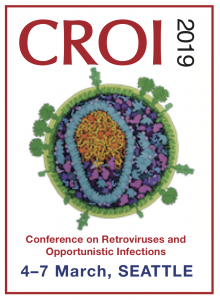Viral reservoir can explain persistent low level viraemia with good adherence on ART
12 March 2019. Related: Conference reports, Treatment strategies, CROI 26 (Retrovirus) 2019.
 Simon Collins, HIV i-Base
Simon Collins, HIV i-Base
The dynamics of HIV proliferation in the viral reservoir might be the explanation for why viral load fails to become undetectable, especially when adherence is good.
Such cases are often reported as a management challenge in the absence of drug resistance at baseline and when ART is started in very early infection. Anecdotally, replication in the viral reservoir has been suggested as a possible mechanism to explain this and this hypothesis is now supported by results from an oral presentation at CROI 2019.
Elias Halvas from the University of Pittsburgh and colleagues presented results that amplified HIV in 10 participants with persistent low level viral load for > 6 months on ART (>50 to <200 copies/mL).
Median viral load and CD4 count was 98 copies/mL and 542 cells/mm3, and at baseline (pre-ART) was 189,000 copies/mL and 212 cells/mm3, respectively. Median cell associated HIV DNA and RNA at the time of the analysis was 1458 and 166 copies/million PBMCs respectively and was detectable in all ten participants.
The study used single-genome sequencing on plasma RNA, cell-associated DNA, and p24+ culture supernatants from quantitative viral outgrowth assays (qVOA). Phylogenetic analysis and integration site analysis was able to show the lack of viral evolution or variation in integration sites.
Although 1/10 participant was excluded due to drug resistance linked to ongoing HIV replication, all other sequences confirmed lack of viral evolution and the viral source was from clonal replication.
This showed that low level viral load was not the result of ongoing viral replication linked to suboptimal adherence or ART but was due to cell proliferation in the viral reservoir.
The study also concluded that the finding might have implications for cure-related research as this clonal reservoir might lead to more rapid viral rebound if ART is stopped in context of an analytic treatment interruption.
comment
This was an important presentation as it provided a probable explanation as to why some patients have low level viraemia despite having therapeutic drug levels with no evidence of resistance on repeated testing and likely excellent adherence. It also provides an explanation for the failure of many intensification and ART switch studies to drive the viral load to undetectable levels, as well as prompting a rethink to strategies aimed at HIV cure.
It is accepted that ART cannot cure HIV infection because of the persistence of a small number of latently infected cells in a state of reversible non-productive infection which do not appreciably decay, but with the capability to produce replication-competent proviruses. Previous research has shown that clonally expanded cells containing replication competent proviruses comprise a proportion of this HIV reservoir.
The aim of the research group was to determine whether, in those with persistent low-level viraemia (LLV; 40-200 copies/mL), this resulted from viral replication or clonal expansion. Ten patients were enrolled, and samples analysed by quantification assays and single gene sequencing of plasma RNA and proviral DNA, together with assays for clonal expansion. On one illustrative patient whose data was presented, HIV DNA sequences from PBMC, sequences from p24 positive QVOA wells, and HIV integration site analysis matched with RNA sequences taken at two different time points.
Hence, this study demonstrates how important it is to understand that persistent low level viraemia is not always indicative of poor adherence (as is often thought) and does not necessarily need ART manipulation or intensification if alternative causes have been ruled out, such as resistance.
Whether persistent low-level viremia between >50 and <200 copies/mL predicts virologic failure (VF) is unclear. VF rates of up to 8-10% have been reported in some studies with emergence of drug resistance observed with cumulative risk dependent upon the height of the baseline level within this range.
In contrast, other researchers have demonstrated no increased risk of VF compared to those with persistent undetectable levels and lack of any genetic evolution on sequential samples taken over time.
Moreover, exactly what constitutes persistent low-level viraemia has not been defined, making comparisons between studies difficult. Nevertheless, between from 25 to 50% of VL measurements are between >50-<200 copies/mL at least 6 months after ART initiation.
How to manage this situation is debatable. A single VL measurement between 50-199 copies/mL should prompt a repeat test within 2-4 weeks including a resistance assay as well as an assessment of adherence and potential drug-drug interactions. If the repeat level again shows LLV with wild-type virus on resistance testing and adherence is not an issue, it would be reasonable to wait a further month and repeat the VL for a second time with a further resistance assay and, if available, obtain drug levels.
Often, patients with persistent LLV do have occasional levels which are undetectable which is reassuring. However, there is limited guidance as to how best to manage this situation and it will be a doctor-patient choice in the end.
Reference
Halvas EK et al. Nonsuppressible viremia on ART from large cell clones carrying intact proviruses. CROI 4 – 7 March 2019, Seattle. Oral abstract 23.
http://www.croiconference.org/sessions/nonsuppressible-viremia-art-large-cell-clones-carrying-intact-proviruses (abstract)
http://www.croiwebcasts.org/console/player/41059 (webcast)

